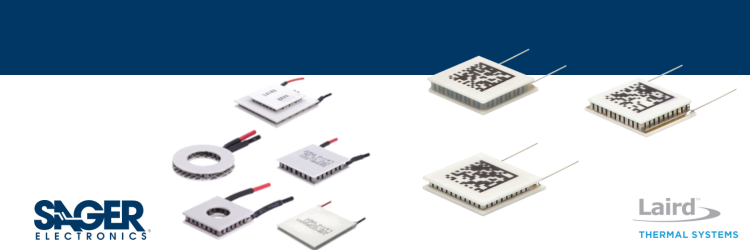Thermoelectric Coolers: Efficient, Compact Cooling for High Performance Applications
Sponsored by Sager Electronics
Thermoelectric coolers (TECs) provide a compact, efficient alternative to traditional cooling systems like compressor-based chillers and fan assemblies. Unlike conventional systems, TECs use a unique, versatile heat pump transfer process. This technology rapidly achieved mass adoption across many industries, from medical diagnostics to optoelectronics in automotive and telecommunications.
What Are Thermoelectric Coolers?
Thermoelectric coolers are compact devices that transfer heat from one side to another using a thermoelectric semiconductor material. When current is applied to a TEC, one side becomes hot, and the other becomes cold, creating a heat-pumping effect allowing to cool below ambient. With most models small enough to fit in the palm of your hand, TECs provide an efficient solution for applications that need compact, localized cooling.
We talked with Andrew Dereka, Product Director at Laird Thermal Systems, and Vineet Barot, Technical Support Manager at Sager Electronics, to learn more about the technology.
According to Dereka. Thermoelectrics use a bismuth telluride semiconductor material that has excellent thermal insulating properties. These materials are designed to operate effectively within a specific temperature range and have been refined through incremental advances in manufacturing, offering improved performance without significant increases in size or power consumption.
Thermoelectric Cooler Applications
Thermoelectric coolers can be used across many industries. Medical diagnostics is one area where TECs are a great option since they keep sample reagents cool during testing processes, preventing spoilage and ensuring accurate results. They can also be in optoelectronics, where they stabilize temperatures for lasers used in high-speed data transmission for telecom and datacom markets.
Another emerging application for TECs is in the automotive industry, where they are used to maintain peak performance of optical electronics in autonomous systems. Surprisingly, TECs have also entered niche markets like gaming, where high-end users integrate TECs with liquid cooling systems to lower GPU temperatures and maximize gaming performance.
Key Benefits of TECs
TECs offer several advantages over traditional cooling methods. Their compact size, lightweight structure, and ability to switch between heating and cooling make them versatile. TECs can achieve below-ambient temperatures, a capability that fan-based cooling systems cannot offer. They also operate on standard DC voltage, which can be easily integrated into many applications, especially in medical and analytical instruments.
Another unique advantage of TECs is their ability to switch between heating and cooling modes almost instantly, simply by reversing the current. This makes them ideal for applications that require precise temperature stability, like certain LiDAR systems in autonomous vehicles. TECs can maintain a consistent temperature to maintain optimal performance as temperature fluctuations occur.
Challenges and Future Developments
While TECs offer impressive benefits, they do have limitations. According to Barot, TECs are not suitable for every application. Their heat-pumping capacity is lower than compressor-based systems, making them less effective for high-power devices. TECs are also more costly than traditional fans and require careful assembly with clean, polished surfaces and minimal thermal grease to ensure efficiency.
Looking ahead, the TEC industry is pushing for even smaller and more efficient models to meet the growing demand for miniaturization. Advancements in materials science and refined manufacturing processes are showing incremental improvements, although breakthroughs in TEC performance tend to come slowly.
Conclusion
Thermoelectric coolers are a compact, efficient solution for applications requiring localized temperature control. Their unique ability to cool below ambient levels and switch seamlessly between heating and cooling makes them ideal for medical, industrial, and consumer applications. As TEC technology advances, we can expect to see even greater adoption across industries seeking reliable, versatile cooling solutions.
Learn more about everything Vineet and Andrew discussed:

